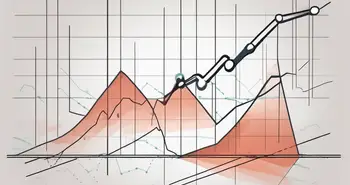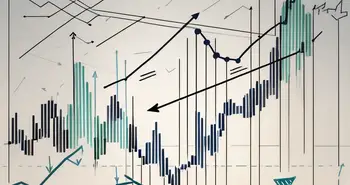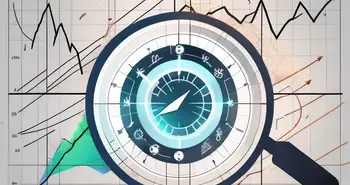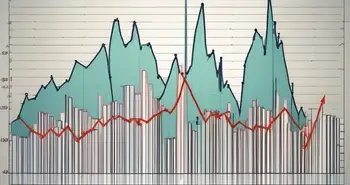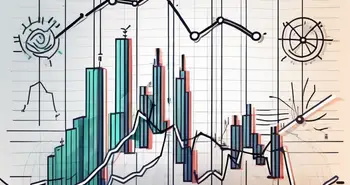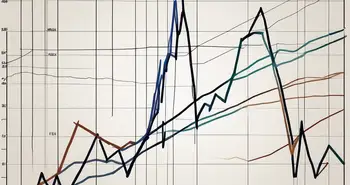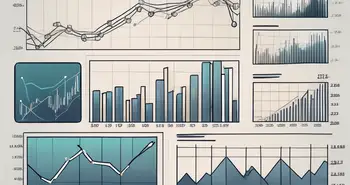A Pro Guide on the Bullish Percent Index
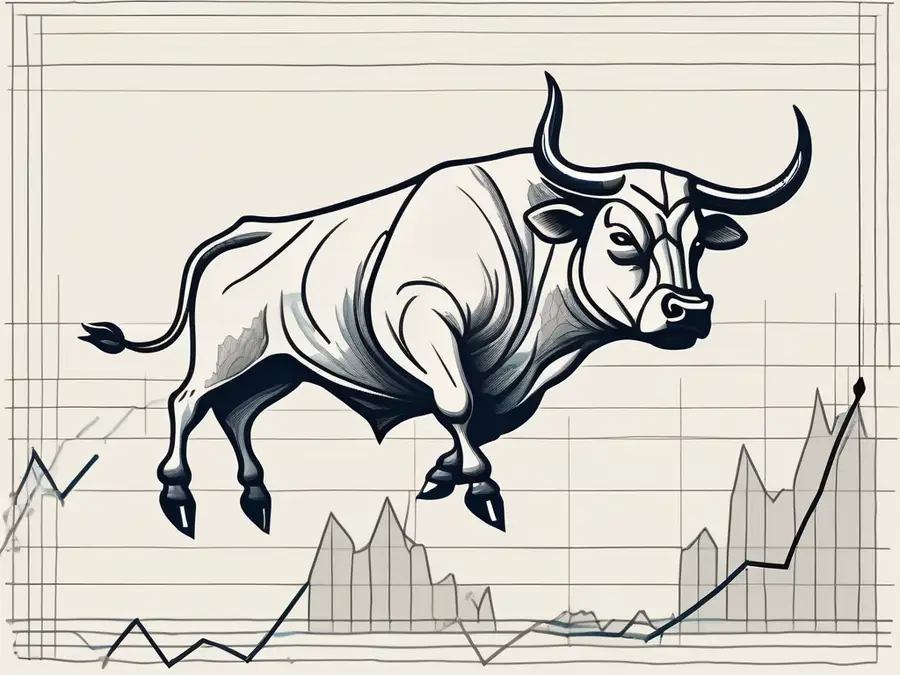
As someone who has spent years analyzing market trends and indicators, I can confidently say that understanding the Bullish Percent Index is crucial for any serious trader. In this comprehensive guide, we will dive deep into the concept, calculation, interpretation, risk management, and strategies for using this powerful tool. So, let's get started!
What is the Bullish Percent Index?
If you are new to trading or technical analysis, you might wonder what exactly the Bullish Percent Index is. Simply put, it is a market breadth indicator that measures the percentage of stocks in a given group or index that are displaying bullish signals. It provides valuable insights into the overall market sentiment and helps traders identify potential buying or selling opportunities.
The Bullish Percent Index is a widely used tool in the world of finance and investing. It is based on the principle that stock market movements follow identifiable patterns. By tracking the proportion of stocks in an index that are currently trading in bullish territories, the index provides a snapshot of market sentiment and helps traders gauge the strength and direction of prevailing trends.
Understanding the Bullish Percent Index is crucial for traders who want to make informed decisions in the market. By analyzing the index, traders can gain valuable insights into the overall market sentiment and adjust their strategies accordingly.
The Concept of Bullish Percent Index
At its core, the Bullish Percent Index operates on the belief that stock market movements follow identifiable patterns. It tracks the proportion of stocks in an index that are currently trading in bullish territories, usually defined by the breaking of resistance levels or the formation of bullish chart patterns.
For example, if the Bullish Percent Index for the S&P 500 is 70%, it means that 70% of the stocks in the index are showing positive price trends, indicating a generally bullish market sentiment.
The Bullish Percent Index is calculated by dividing the number of stocks in an index that are currently displaying bullish signals by the total number of stocks in the index, and then multiplying the result by 100 to get a percentage. This percentage represents the overall bullishness of the market.
It is important to note that the Bullish Percent Index is not a predictive indicator. It simply provides a snapshot of the current market sentiment and helps traders identify potential opportunities or risks.
The Importance of Bullish Percent Index in Trading
The Bullish Percent Index is a powerful tool for traders because it provides a comprehensive overview of market sentiment. By analyzing the index, traders can gain valuable insights into the strength and direction of prevailing trends, enabling them to make informed trading decisions.
Having a clear understanding of the market sentiment is essential for successful trading. Being aware of whether the market is bullish, bearish, or in a neutral state allows traders to adjust their strategies accordingly and identify potential opportunities or risks.
Traders often use the Bullish Percent Index in conjunction with other technical indicators to confirm or validate their trading decisions. By combining the information provided by the index with other tools such as moving averages, trend lines, or volume indicators, traders can increase their chances of success in the market.
It is worth noting that the Bullish Percent Index can vary across different sectors or industries. For example, the technology sector may have a higher Bullish Percent Index compared to the energy sector, indicating a stronger bullish sentiment in technology stocks.
In conclusion, the Bullish Percent Index is a valuable tool for traders and investors. It provides insights into market sentiment and helps identify potential buying or selling opportunities. By understanding and analyzing the index, traders can make informed decisions and increase their chances of success in the market.
The Calculation of the Bullish Percent Index
Now that we have a basic understanding of the concept, let's explore how the Bullish Percent Index is calculated. It involves two fundamental components: point and figure charts and mathematical formulas.
Understanding Point and Figure Charts
Point and figure charts are widely used in technical analysis to identify trends and support/resistance levels. Unlike traditional candlestick or line charts, point and figure charts focus solely on price movements, filtering out minor fluctuations and providing a clearer picture of significant price changes.
These charts consist of columns of X's and O's. X's represent rising prices, while O's represent falling prices. Each column represents a specific price range, and the height of the column indicates the magnitude of the price movement. By analyzing these patterns, analysts can identify key levels of support and resistance, as well as potential trend reversals.
Using point and figure charts, analysts can track the percentage of stocks in an index that have reversed their previous downtrends and entered bullish territory. This information is the foundation of the Bullish Percent Index calculation.
The Mathematical Formula Behind the Index
The specific mathematical formula used to calculate the Bullish Percent Index varies depending on the chosen methodology or software. However, the general principle is relatively simple. It involves dividing the number of stocks in a group or index that are exhibiting bullish characteristics (according to predefined criteria) by the total number of stocks in the same group.
For example, if there are 50 stocks in an index and 35 of them meet the bullish criteria, the Bullish Percent Index would be calculated as 70% (35/50 * 100%). This index value helps traders gauge the overall market sentiment.
The Bullish Percent Index is a valuable tool for investors and traders as it provides insights into the strength of bullish sentiment in the market. By monitoring this index, market participants can identify potential shifts in market sentiment and make informed decisions.
It is important to note that the calculation of the Bullish Percent Index is not a standalone indicator. It is often used in conjunction with other technical analysis tools and indicators to confirm or validate trading signals. By combining multiple indicators, traders can increase the probability of making successful trades.
In addition to its application in individual stocks, the Bullish Percent Index can also be calculated for various market indexes, sectors, or even countries. This allows traders to assess the overall market conditions and make broader investment decisions.
Overall, the Bullish Percent Index is a powerful tool that provides valuable insights into market sentiment. By understanding its calculation and incorporating it into their analysis, traders can enhance their decision-making process and potentially improve their trading outcomes.
Interpreting the Bullish Percent Index
Once we understand the concept and calculation of the Bullish Percent Index, the next step is to learn how to interpret it to make accurate trading decisions.
Reading the Bullish Percent Index
The Bullish Percent Index is typically displayed as a percentage ranging from 0 to 100%. As a general rule, values above 70% indicate an overbought market, suggesting a potential reversal or correction. Conversely, values below 30% suggest an oversold market, signaling a potential buying opportunity.
The Role of Market Trends in Interpretation
While the Bullish Percent Index is a powerful tool, it is important to consider it in the context of broader market trends. For example, an index may have a high Bullish Percent Index of 80%, but if the overall market is in a downtrend, this could be a false signal.
Traders should use the Bullish Percent Index in conjunction with other technical analysis tools, such as trend lines, moving averages, and volume indicators, to validate signals and make more accurate predictions.
The Bullish Percent Index and Risk Management
Risk management is a crucial aspect of successful trading, and the Bullish Percent Index can help in this regard by providing insights into potential market risks and opportunities.
Using the Index for Portfolio Protection
The Bullish Percent Index can help traders identify periods of increased market risk. For example, when the index is showing overbought conditions, it may be prudent to tighten stop-loss orders or reduce exposure to avoid potential losses in the event of a market reversal.
The Index as a Tool for Diversification
Diversification is another key element in risk management, and the Bullish Percent Index can be instrumental in guiding portfolio diversification strategies. By monitoring different indices across various sectors, traders can identify sectors or industries that are showing stronger bullish trends, providing opportunities for diversification and potentially reducing the overall risk of their portfolio.
Strategies for Using the Bullish Percent Index
Now that we have explored the concept, calculation, interpretation, and risk management aspects of the Bullish Percent Index, let's take a look at some strategies for utilizing this powerful indicator.
Timing the Market with the Bullish Percent Index
Timing the market can be challenging, but the Bullish Percent Index can provide valuable insights. By analyzing the index and identifying periods of overbought or oversold conditions, traders can time their entries or exits more effectively.
Combining the Index with Other Indicators
The Bullish Percent Index is most effective when combined with other technical analysis tools. By using multiple indicators, such as moving averages, trend lines, and volume analysis, traders can increase the accuracy and reliability of their trading signals.
I hope this comprehensive guide has given you a solid understanding of the Bullish Percent Index and its significance in trading. Remember, successful trading requires continuous learning and adapting to market conditions. By incorporating the Bullish Percent Index into your analysis and strategy, you can gain a competitive edge and make more informed trading decisions.
FAQs
Q: What is the Bullish Percent Index?
A: The Bullish Percent Index is a market breadth indicator that measures the percentage of stocks in a given group or index displaying bullish signals. It helps traders identify potential buying or selling opportunities by providing insights into market sentiment.
Q: How is the Bullish Percent Index calculated?
A: The Bullish Percent Index is calculated by dividing the number of stocks in a group or index that meet predefined bullish criteria by the total number of stocks in the same group or index.
Q: How should I interpret the Bullish Percent Index?
A: Values above 70% indicate an overbought market, suggesting a potential reversal or correction. Values below 30% suggest an oversold market, signaling a potential buying opportunity. However, it is essential to consider the Bullish Percent Index in the context of broader market trends.
Q: How can I use the Bullish Percent Index for risk management?
A: The Bullish Percent Index can help in risk management by identifying periods of increased market risk and guiding portfolio diversification strategies. It can help traders make informed decisions regarding stop-loss orders and reduce overall portfolio risk.
Q: What are some strategies for using the Bullish Percent Index?
A: Traders can utilize the Bullish Percent Index for timing their market entries or exits by analyzing overbought or oversold conditions. It is also advisable to combine the index with other technical analysis tools for increased accuracy and reliability of trading signals.
Q: How can I incorporate the Bullish Percent Index into my trading strategy?
A: To incorporate the Bullish Percent Index into your trading strategy, monitor the index regularly, validate signals with other indicators, and consider the index's findings in the context of broader market trends. Continuous learning and adaptability are key to successful trading.
Now that you're equipped with the knowledge of the Bullish Percent Index and how it can enhance your trading strategy, it's time to put that knowledge into action. Morpher.com offers you a revolutionary trading platform that aligns perfectly with the dynamic nature of market indicators. With its zero-fee structure, infinite liquidity, and the ability to trade across a multitude of asset classes, Morpher is the ideal platform for traders who value innovation and flexibility. Whether you're looking to leverage the Bullish Percent Index for stocks, cryptocurrencies, or even niche markets, Morpher's unique trading experience has got you covered. Sign Up and Get Your Free Sign Up Bonus today to transform your trading with the power of blockchain technology.

Disclaimer: All investments involve risk, and the past performance of a security, industry, sector, market, financial product, trading strategy, or individual’s trading does not guarantee future results or returns. Investors are fully responsible for any investment decisions they make. Such decisions should be based solely on an evaluation of their financial circumstances, investment objectives, risk tolerance, and liquidity needs. This post does not constitute investment advice.

Painless trading for everyone
Hundreds of markets all in one place - Apple, Bitcoin, Gold, Watches, NFTs, Sneakers and so much more.

Painless trading for everyone
Hundreds of markets all in one place - Apple, Bitcoin, Gold, Watches, NFTs, Sneakers and so much more.


